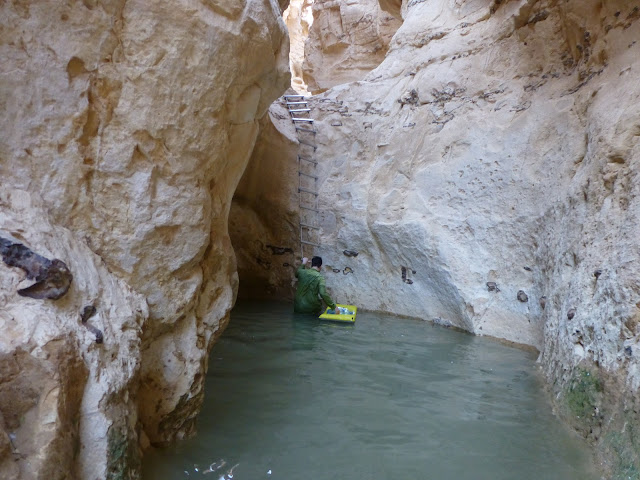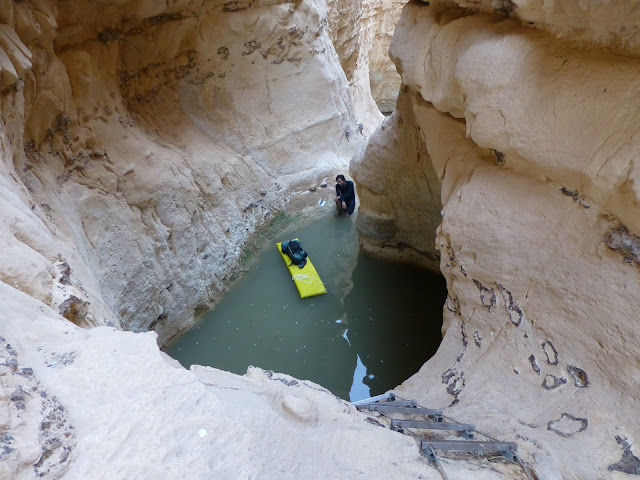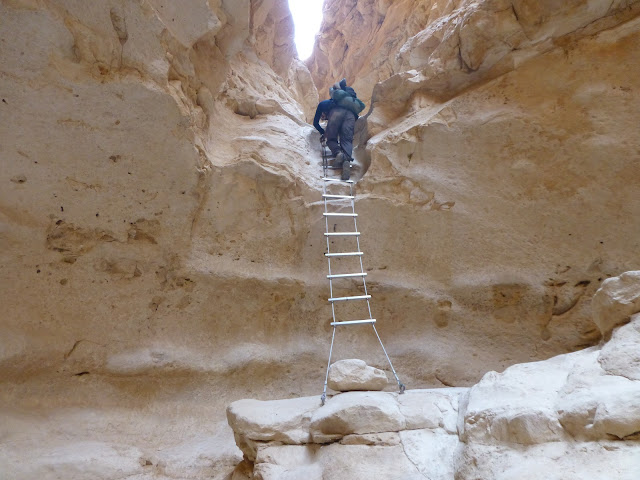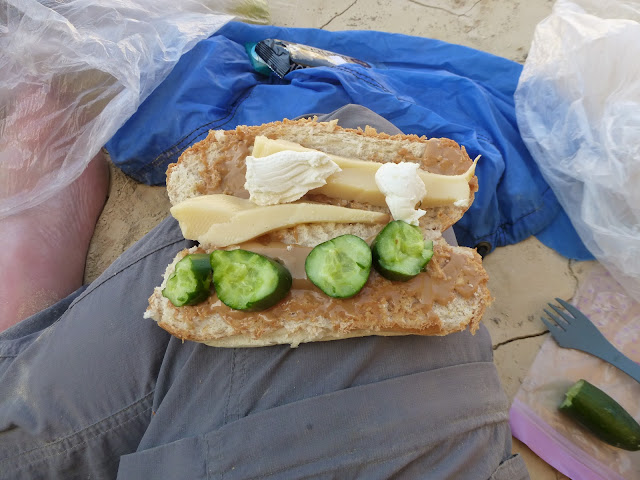Ok, I survived the not-so-short hike.
Our hike started after a long train ride to Be'er-Sheva, and a bus ride to Tzihur Junction (on the bus to Eilat) - a
total of about 4 hours on the road. We started our actual walking at 10:15. A bit on the late side. We tried
convincing the bus driver to drop us off near the trailhead, but he didn't like the idea, and dropped at at the
junction, so add about 2Km of road walk to our first day.

|
| An impressive tree, near the start of our hike
|
After finally reaching the trailhead we started hiking northbound on the Israel National Trail. About 3 hours of 4x4
road walking later, we finally reached the Vardit Canyon, and had a blast - At the first water hole we met a small
group of 4 who got there by jeep, and they enjoyed watching us trying to get across the water in one piece.
It was possible to cross over the left canyon wall, and avoid getting wet. But we heard from a southbound hiker
we've met several minutes before, that there is one water hole that required proper swimming, so we figured there's
no point in trying to remain dry. I just waded in carefully, trying to walk along the outskirts of the hole, and
keeping my backpack above water. Yair inflated his Neo-Air mattress, and waded across with his backpack floating on
top of it. A very good idea indeed.

|
| After crossing the first water hole, Yair is inflating his mattress for his own
attempt
|
A short climb up some metal rings later, we met THE water hole. There was no walking around that one, with cliffs
along all sides, and a metal ladder at the far end. This hole was also much deeper, and indeed required proper
swimming. This time we made arrangements to use the Neo-Air for all of our gear. It took some time, but at the end
we both made it to the top. We were completely wet, but the backpacks weren't, so I guess it worked. The only
downside was that my hiking pants got torn pretty badly when I slipped inside the water one time.

|
| The big water hole, getting the water bottles across using the inflatable mattress
|
After that hole there was some more climbing up metal rings, another ladder, and more rings to finish it up. I
enjoyed this section.

|
| Yair using his mattress to keep his backpack (mostly) dry
|
We were aiming at Mounta Kipah camping area, but I guess it was too far away, especially after starting as late as
we did, so after thinking we were further along than we actually were, and finding out we still have about 8 more Km
until we get there, and 30 minutes of sunlight, we just gave up and decided to find a place to stealth camp.
Luckily, we did find a very nice spot for our tents, and went to sleep early. I think we were both out by
19:00.

|
| My gear at camp - TarpTent Rainbow, Neo-Air, ZPacks quilt and Arc-Blast
|
The second day started with a short hike to Barak Canyon, this time climbing down. The trail first turned north,
headed down the eastern slopes of the canyon, and reached its bottom. From there it followed it down along 3 more
ladders, several sections of metal rings, and a short section of sliding along a smooth rock surface (with foot
grooves) while holding a rope. It was very adventurous.
Sadly, the bit after the canyon was not as exciting. It was a long ~30Km 4x4 road walk, mostly north towards Tzofar.
No major climbs up nor down. The view was pretty nice most of the time, but after several Km of walking in the sun
it wasn't as exciting anymore. We bumped into several groups going south - some also doing the INT in sections, and
one really large group (over 50 hikers, for sure), that passed us by when we were struggling to fit under a small
rock outcrop for shade, and have lunch.

|
| Climbing down the tallest ladder in Barak Canyon
|

|
| Having a peanut butter-cheese-goat cheese-cucumber bun for lunch. I later added some
pesto sauce as well
|
For the first time ever, we actually made a navigation error and were surprised in a positive way - we kept looking
for a junction with a green trail heading east, and we didn't see it, so we thought we have at least 4 more Km util
Horvat Mo'aa, and 2.5Km from there to the road. It was getting late again, and our soles hurt from all that non-stop
walking, when suddenly we saw Horvat Mo'aa just a short ways off. It was a very pleasent surprise. I set there in
the shade, while Yair went over to check the old Nabataeans fort.

|
| Horvat Mo'aa near the end of our hike
|
From there, it was a race against time to get to the road, and from there another 1.5Km to the bus station, by
17:15, to catch our bus back home. We made it by 17:13, and the bus was several minutes late, but it was good.
In total, we did about 52.9Km in two days. I think that's a bit impressive.
View צומת ציחור לחרבת מואה in a larger map
My Gear
So, this was the first time I used my new Arc-Blast backpack, and ZPacks quilt. I carried many extra pieces of gear
in the backpack, and a lot of extra food, just to try and simulate a heavier backpack I will be carrying on the PCT.
With 7.5 Liters of water, and was no fun to put it on my back. But it carry it well. The outside pockets worked well
for 3 extra bottles of water and the closing system worked well (I was afraid the velcro at the top will be annoying
to open and close during the hike).
Some things I didn't like about the backpack, which I hope I get used to on the longer hike - I am not overly thin
(an understatement), and yet I had the belt buckle tight almost all the way. I will lose some weight on the PCT, so
I hope the belt will still be effective. Another small thing - my right shoulder and lower back did hurt a bit at
the end. Again, I hope I'll get in better shape on the trail, and they will hold better once I get used to the daily
mileage.
The quilt was very nice and comfy. At first I opened the clips and used it as a standard quilt, but it did get
chilly so I closed it at night. Using the cinch cord at the top also made all the difference - without it I would
definitely be a bit colder inside, but when I pulled it shut, it was very toasty indeed.
Other than that, I have to remember to get my Neo-Air not completely full - taking out a bit of air before I go to
sleep will make it much more comfortable on my back. I also cooked by only boiling water in my Caldera Cone Keg, and
then pouring it into the bag of my lunch. Waiting for 10 minutes - it worked like a charm. The rice was ready. I
also added in mashed potato mix, and had a lot of "stuff" to eat for dinner. I didn't even finish it all. But it was
tasty.
We never did try filtering water with the Sawyer Mini Filter. I carried an extra liter of dirty water with me for
the entire trip (After filling it up in Vardit Canyon), but our water were enough, and we never tested the filter
this time. Maybe next time.